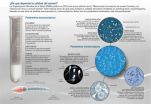(Press-News.org) January 17, 2013--Nyon, Switzerland
Sarcopenia, or the gradual loss of muscle mass, is a common consequence of ageing, and poses a significant risk factor for disability in older adults. As muscle strength plays an important role in the tendency to fall, sarcopenia leads to an increased risk of fractures and other injuries.
The International Osteoporosis Foundation (IOF) Nutrition Working Group has published a new review which identifies nutritional factors that contribute to loss of muscle mass, or conversely, are beneficial to the maintenance of muscle mass. The Group reviewed evidence from worldwide studies on the role of nutrition in sarcopenia, specifically looking at protein, acid–base balance, vitamin D/calcium, and other minor nutrients like B vitamins.
"The most obvious intervention against sarcopenia is exercise in the form of resistance training," said Professor Jean-Philippe Bonjour, co-author and Professor of Medicine at the Service of Bone Diseases, University of Geneva. "However, adequate nutritional intake and an optimal dietary acid-base balance are also very important elements of any strategy to preserve muscle mass and strength during ageing."
The review discusses and identifies the following important nutritional factors that have been shown to be beneficial to the maintenance of muscle mass and the treatment and prevention of sarcopenia:
Protein:
Protein intake plays an integral part in muscle health. The authors propose an intake of 1.0–1.2 g/kg of body weight per day as optimal for skeletal muscle and bone health in elderly people without severely impaired renal function.
Vitamin D:
As many studies indicate a role for vitamin D in the development and preservation of muscle mass and function, adequate vitamin D should be ensured through exposure to sunlight and/or supplementation if required. Vitamin D supplementation in seniors, and especially in institutionalized elderly, is recommended for optimal musculoskeletal health.
Avoiding dietary acid loads:
Excess intake of acid-producing nutrients (meat and cereal grains) in combination with low intake of alkalizing fruits and vegetables may have negative effects on musculoskeletal health. Modifying the diet to include more fruits and vegetables is likely to benefit both bones and muscles.
Emerging evidence also suggests that vitamin B12 and/or folic acid play a role in improving muscle function and strength. As well, the Review discusses non-nutritional interventions such as hormones, and calls for more studies to identify the potential of antioxidants and anti-inflammatory compounds in the prevention of sarcopenia.
Dr. Ambrish Mithal, co-author and Chair and Head of Endocrinology and Diabetes division at Medanta, New Delhi underlined the need for further research in the field. "Strategies to reduce the numbers of falls and fractures within our ageing populations must include measures to prevent sarcopenia. At present, the available evidence suggests that combining resistance training with optimal nutritional status has a synergistic affect in preventing and treating sarcopenia," said Mithal.
"We hope that further studies will shed light on other effective ways of preventing and treating this condition."
###
Reference:
Impact of nutrition on muscle mass, strength, and performance in older adults. A. Mithal & J.-P. Bonjour & S. Boonen & P. Burckhardt & H. Degens & G. El Hajj Fuleihan & R. Josse & P. Lips & J. Morales Torres & R. Rizzoli & N. Yoshimura & D. A. Wahl & C. Cooper & B. Dawson-Hughes & for the IOF CSA Nutrition Working Group. Osteoporos Int DOI 10.1007/s00198-012-2236-y
http://link.springer.com/article/10.1007/s00198-012-2236-y. END
Which nutritional factors help preserve muscle mass, strength and performance in seniors?
New review by International Osteoporosis Foundation Nutrition Working Group examines role of nutrition in sarcopenia, with focus on protein, vitamins D and B, and acid-based diet.
2013-01-18
ELSE PRESS RELEASES FROM THIS DATE:
Cell: Protein folding via charge zippers
2013-01-18
This press release is available in German.
Membrane proteins are the "molecular machines" in biological cell envelopes. They control diverse processes, such as the transport of molecules across the lipid membrane, signal transduction, and photosynthesis. Their shape, i.e. folding of the molecules, plays a decisive role in the formation of, e.g., pores in the cell membrane. In the Cell magazine, researchers of Karlsruhe Institute of Technology and the University of Cagliari are now reporting a novel charge zipper principle used by proteins to form functional units ...
The cell that isn't
2013-01-18
This may look like yet another video of a dividing cell, but there's a catch. You are looking at chromosomes (red) being pulled apart by the mitotic spindle (green), but it's not a cell, because there's no cell membrane. Like a child sucking an egg out of its shell, Ivo Telley from the European Molecular Biology Laboratory (EMBL) in Heidelberg, Germany, removed these cellular 'innards' from a fruit fly embryo, at a stage when it is essentially a sac full of membrane-less 'cells' that divide and divide without building physical barriers to separate themselves from each other.
"It's ...
Increasing concerns surrounding surrogacy
2013-01-18
COUPLES seeking to build a family, and surrogate mothers overseas who help them, are in danger of emotional, physical and financial exploitation unless UK authorities monitor and regulate the field much more closely, according to a University of Huddersfield professor who has published the results of a detailed investigation.
Eric Blyth – Professor of Social Work at the University of Huddersfield, and based at its Centre for Applied Childhood Studies – is co-author of The changing face of surrogacy in the UK, an article which charts the rapid increase in the numbers of ...
Semen quality of young men in south-east Spain down by 38 percent in the last decade
2013-01-18
The first comparative study on the evolution of sperm quality in young Spanish men over ten years, headed by researchers at the University of Murcia, reveals that spermatozoid concentration in men between 18 and 23 years in the regions of Murcia and Almeria has dropped by an annual average of 2%.
The suspicion that the semen of Spanish men is losing quality now takes force in the case of young men from Murcia and Almeria.
The 'Andrology' journal has published a multidisciplinary and international study, headed by the Department of Preventative Medicine and Public ...
Unrestricted access to the details of deadly eruptions
2013-01-18
Volcanic eruptions have the potential to cause loss of life, disrupt air traffic, impact climate, and significantly alter the surrounding landscape. Knowledge of the past behaviours of volcanoes is key to producing risk assessments of the hazards of modern explosive events.
The open access database of Large Magnitude Explosive Eruptions (LaMEVE) will provide this crucial information to researchers, civil authorities and the general public alike.
Compiled by an international team headed by Dr Sian Crosweller from the Bristol's School of Earth Sciences with support from ...
Breakthrough for solar cell research
2013-01-18
In the latest issue of Science, researchers from Lund University in Sweden have shown how nanowires could pave the way for more efficient and cheaper solar cells.
"Our findings are the first to show that it really is possible to use nanowires to manufacture solar cells", says Magnus Borgström, a researcher in semiconductor physics and the principal author.
Research on solar cell nanowires is on the rise globally. Until now the unattained dream figure was ten per cent efficiency – but now Dr Borgström and his colleagues are able to report an efficiency of 13.8 per cent. ...
Climate change to profoundly affect the Midwest in coming decades
2013-01-18
ANN ARBOR—In the coming decades, climate change will lead to more frequent and more intense Midwest heat waves while degrading air and water quality and threatening public health. Intense rainstorms and floods will become more common, and existing risks to the Great Lakes will be exacerbated.
Those are some of the conclusions contained in the Midwest chapter of a draft report released last week by the federal government that assesses the key impacts of climate change on every region in the country and analyzes its likely effects on human health, water, energy, transportation, ...
ARS scientists test improved stink bug trapping methods
2013-01-18
This press release is available in Spanish.
Baited black traps in a pyramid shape attract significantly more brown marmorated stink bugs than other traps, according to U.S. Department of Agriculture (USDA) scientists. Evaluating stink bug responses to different visual stimuli may help manufacturers design better traps for monitoring the bugs.
Entomologist Tracy Leskey at the Agricultural Research Service (ARS) Appalachian Fruit Research Station in Kearneysville, W.V., focused on visual stimuli that can attract the stink bugs to traps that will help farmers monitor ...
Studying ancient Earth's geochemistry
2013-01-18
Washington, D.C.— Researchers still have much to learn about the volcanism that shaped our planet's early history. New evidence from a team led by Carnegie's Frances Jenner demonstrates that some of the tectonic processes driving volcanic activity, such as those taking place today, were occurring as early as 3.8 billion years ago. Their work is published in Geology.
Upwelling and melting of the Earth's mantle at mid-ocean ridges, as well as the eruption of new magmas on the seafloor, drive the continual production of the oceanic crust. As the oceanic crust moves away ...
Wild animals may contribute to the resurgence of African sleeping sickness
2013-01-18
Wild animals may be a key contributor to the continuing spread of African sleeping sickness, new research published in PLOS Computational Biology shows. The West African form of the disease, also known as Gambiense Human African trypanosomiasis, affects around 10,000 people in Africa every year and is deadly if left untreated.
The disease is caused by a brain-invading parasite transmitted by bites of the tsetse fly, and gets its name from the hallmark symptoms of drowsiness and altered sleeping patterns that affect late-stage patients, along with other physical and neurological ...
LAST 30 PRESS RELEASES:
Tracing the quick synthesis of an industrially important catalyst
New software sheds light on cancer’s hidden genetic networks
UT Health San Antonio awarded $3 million in CPRIT grants to bolster cancer research and prevention efforts in South Texas
Third symposium spotlights global challenge of new contaminants in China’s fight against pollution
From straw to soil harmony: International team reveals how biochar supercharges carbon-smart farming
Myeloma: How AI is redrawing the map of cancer care
Manhattan E. Charurat, Ph.D., MHS invested as the Homer and Martha Gudelsky Distinguished Professor in Medicine at the University of Maryland School of Medicine
Insilico Medicine’s Pharma.AI Q4 Winter Launch Recap: Revolutionizing drug discovery with cutting-edge AI innovations, accelerating the path to pharmaceutical superintelligence
Nanoplastics have diet-dependent impacts on digestive system health
Brain neuron death occurs throughout life and increases with age, a natural human protein drug may halt neuron death in Alzheimer’s disease
SPIE and CLP announce the recipients of the 2025 Advanced Photonics Young Innovator Award
Lessons from the Caldor Fire’s Christmas Valley ‘Miracle’
Ant societies rose by trading individual protection for collective power
Research reveals how ancient viral DNA shapes early embryonic development
A molecular gatekeeper that controls protein synthesis
New ‘cloaking device’ concept to shield sensitive tech from magnetic fields
Researchers show impact of mountain building and climate change on alpine biodiversity
Study models the transition from Neanderthals to modern humans in Europe
University of Phoenix College of Doctoral Studies releases white paper on AI-driven skilling to reduce burnout and restore worker autonomy
AIs fail at the game of visual “telephone”
The levers for a sustainable food system
Potential changes in US homelessness by ending federal support for housing first programs
Vulnerability of large language models to prompt injection when providing medical advice
Researchers develop new system for high-energy-density, long-life, multi-electron transfer bromine-based flow batteries
Ending federal support for housing first programs could increase U.S. homelessness by 5% in one year, new JAMA study finds
New research uncovers molecular ‘safety switch’ shielding cancers from immune attack
Bacteria resisting viral infection can still sink carbon to ocean floor
Younger biological age may increase depression risk in older women during COVID-19
Bharat Innovates 2026 National Basecamp Showcases India’s Most Promising Deep-Tech Ventures
Here’s what determines whether your income level rises or falls
[Press-News.org] Which nutritional factors help preserve muscle mass, strength and performance in seniors?New review by International Osteoporosis Foundation Nutrition Working Group examines role of nutrition in sarcopenia, with focus on protein, vitamins D and B, and acid-based diet.


